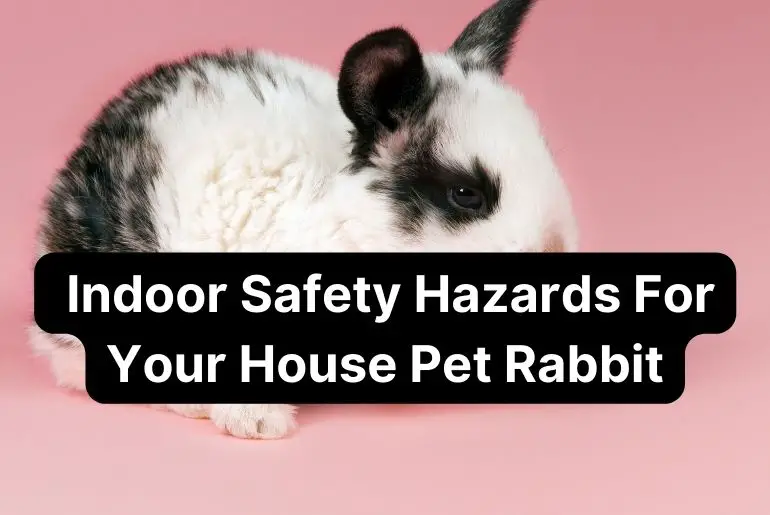What Are Some Indoor Safety Hazards for Your House Pet Rabbit?

It’s nice to have a pet rabbit who can freely roam around the house, but here are some hazards I wasn’t thinking about while my rabbit was having fun around the house exploring.
What Are Some Indoor Safety Hazards for Your House Pet Rabbit?
- Household plants
- Fireplaces, candles, and open fires
- Washing and drying machines
- Open doors, windows, and balconies
- Stairs
- Furniture
- Carpet fibers
- Gaps in the walls, holes around the house
- Exposed electrical cables
- Rabbit roaming around the kitchen while you cook
Rabbits are great indoor pets, and they don’t require walking or any special activities. As long as your house is hazard-free (as much as possible) and you provide enough toys, food, water, and other essentials, your bunny friend will be happy and your life easier.
Contents
Household Plants
Rabbits love plants, they eat plants, and of course, in nature, they live surrounded by plants. Not all the plants are safe for your rabbit to be around, and if you want to keep your rabbit safe and your plants alive and pretty, you will have to keep it out of the rabbit’s reach.
Fortunately, if you keep your plant pots high enough, your bunny won’t be able to reach them. If your plants have long, overleaning branches or leaves, make sure to stake them up. If the plant is leaning over, there is a possibility for a rabbit to reach it.
There are a lot of toxic plants the rabbit could eat.
Some of the toxic plants for rabbits are:
- Amaryllis
- Azalea
- Aloe Vera
- Asparagus
- Geranium
- Ivy
- Orchid
- Daffodil
- Daisy
This list of toxic plants goes on, so please visit http://actionforrabbits.co.uk/ to see other plants you want to avoid. If you wish to see the list of safe plants (non-toxic) for your rabbit, visit http://actionforrabbits.co.uk to find out more.
Did You Know that ALOE VERA plant is toxic to rabbits??????
If your plants are too big to put on the higher places, make sure, you use some kind of rabbit deterrent. Deterrent repels rabbits from eating the plants since it’s made of a scent they don’t like. Spray it on the pot and around the pot to prevent the plant from being chewed by your bunny. You will have to use this method often in order to keep the rabbit away.
Fireplaces, candle flame, open fires
While you might think that your rabbit is afraid of the fire and won’t go anywhere near it, rabbits are attracted to warmth. There were situations where rabbits got singed orburned near the fireplace fire. Their coats or whiskers could get singed easily. Make sure your fireplace has a fireguard.
Even when your fireplace is out of the fire, a rabbit can get into it and take the coal out, not to mention that it can make itself and the whole house dirty.
If your fireplace has gaps inside or any holes you didn’t notice, the rabbit could easily get into it.
Rabbits can burn their whiskers on the pilot light of gas in the gas fireplace.
Make sure to keep your lighted candles high since the rabbit can singe its whiskers easily.
Washing and drying machines
Believe it or not, rabbits can easily hop into the washing or drying machine. Some households don’t have separate laundry rooms or even a door in the laundry area. There are also cords around or behind the machines that might be interesting for the bunny and potential safety hazards.
While your rabbit might be afraid of the sounds of a washer or dryer when it’s on, being out of use is a different situation. Keep the laundry room door closed, as well as the doors on the washer and dryer. If your laundry area is connected to your living area without the door, make sure to keep all the cords out of reach and secured. Remove all the potential chewing materials, washing detergent, softener, wooden laundry basket, or cleaning tools on the lower shelves and the floor.
Open doors, windows, and balconies
Keep your front or back door closed or any other door that the rabbit can use to escape outside. This is especially important if your door leaves directly to the street or traffic. If it runs directly to the street, the car or another vehicle could hit it. Rabbits are fast and can easily escape.
If you live in areas near the woods and wildlife, your pet can end up as prey. Your house rabbit is not used to being outdoors and won’t be able to survive or to protect itself from predators. Predators don’t have to be wild animals, but they could be a neighbor’s dog.
If you live in an apartment building or upper level of the house, and windows are not high enough or have a safety net on them, your bunny can hop on and fall of the window. Rabbits, like other indoor animals, will spend time looking through the window. Keep your window closed with a rabbit roaming around.
Balconies are another hazard you have to be aware of. A lot of balcony railings have enough space between the pickets for a rabbit to fall.
Stairs
Rabbits are capable of climbing the stairs, but if your stairs are long, steep and the railing has gaps, it’s not safe for your rabbit. It can potentially be a safety hazard for your pet. Stairs might be beautiful and functional for humans, but the rabbit could easily fall if there are gaps on the sides.
To prevent the rabbit from hurting itself or worse, use pet or baby gates on the top or bottom of the stairs (depending on where the rabbits spend more time). Pet gates are widely available but choose the ones that are made of bunny chew-proof materials.
Furniture
Rabbits love chewing wooden furniture. Protective and decorative paints can be toxic for your rabbit. If possible, have the least number of wooden pieces of furniture as possible.
You can protect your furniture and wooden areas of the house by taping them with clear packaging tape. This tape is wide enough, almost invisible, and rabbits don’t like it for some reason.
Monitor your rabbit to see how it reacts to the tape and make sure it doesn’t chew on it and digest it. Rabbits, like any other pet, have their unique personalities.
The bitter spray is another option to keep the rabbit away, but it can be pricy unless you make it yourself. Rabbits don’t like these sprays, and they are non-toxic to them. Remember that you will have to re-spray the areas over and over again as the scents lose over time.
You can make the bitter spray by yourself. Some of the ingredients you can use are apple cider vinegar, lemon juice, water, and essential oils that are safe for rabbits. Use any scent your rabbit doesn’t like but will be pleasant to you and your family.
Did you know that rabbits don’t like peppermint and lavender oil scents??
Carpet fibers
Bunnies love and most likely will chew on your carpets. Carpet fibers can cause serious digestive problems. Make sure to provide much hay to your rabbit, as this is an essential source of fiber to their diet. It will also keep your rabbit busy and away from the carpets.
Remove necessary carpets from the house; it will be easier to keep the house clean. If you have the mats, monitor your rabbit to see if it’s interested in chewing on them. The bitter spray can be used on carpets as well, but if your bunny wants to chew on it, consider buying chewable woven grass mats for rabbits.
Gaps in the walls, holes around the house
Your rabbit’s natural habitat is to live underground and keep itself safe by hiding inside the holes. Indoor rabbits will explore and find any open holes that might exist. Unfortunately, not all the holes and gaps around the house are safe for your rabbit.
Places like unfinished basements or rooms can be interested for your rabbit to explore and get into it. These places can have unprotected cords, wires, and toxic materials that might hurt your rabbit. You would be surprised by the places your rabbit can squeeze in. Make sure to find all the areas in the house and close all the holes and gaps that exist.
Exposed electrical cables
When you are busy with your everyday routine at home, not thinking about what your rabbit is doing outside of its cage, unexpected accidents happen.
Rabbits are masters of gnawing on electrical cords, wires, lamp cords, and cables sitting on the house floors. They can hide behind the furniture or a desk and enjoy gnawing on the cords. Most households have a lot of wires and all kinds of cables and electrical cords tangled together around the desk or behind the couch, and your rabbit will find it.
Whenever it is possible, keep your electrical cords high and out of the rabbit’s reach. If it’s not possible to do so, disconnect the cables you’re not using. This action will prevent an accident if your rabbit does gnaw on it.
Use cord protectors whenever you can. There are special cord protectors infused with the scent that your rabbit won’t like and will stay away from it.
Flexi cable wraps are a great option to organize your cables. These cable wraps are inexpensive and easy to use. They also come in different sizes for single or multiple cords.
For your routers, modems, and any other plugged-in boxes, you can keep it in the plastic box and slide it under the table, bed, desk, or any other area where the size of the box fits perfectly and doesn’t have a gap in between the box and the furniture piece.
Rabbit roaming around the kitchen while you cook
While some rabbits are terrified of the kitchens, mostly because of the sounds of the oven, cooking pots, frying pans, and the smell of garlic and other unpleasant food smells, other rabbits are not afraid at all.
Eventually, your bunny can overcome those fears and become a running hazard around the kitchen. It might happen that the bunny will find its way around your legs while you’re holding a pot or a pan full of hot food and drop it on the rabbit or yourself.
It’s safest to keep a rabbit away from the kitchen when you’re preparing food or making a coffee or tea. Close the kitchen door and keep it in a separate room.
Having a free-roaming bunny in your house is a beautiful experience, but make sure it’s free of hazards as much as possible, and you know your bunny’s behavioral traits.

![Can Rabbits Eat Pumpkin? [How Much Is Safe, Dangers and Benefits]](https://petcoddle.com/wp-content/uploads/2022/07/can-rabbits-eat-pumpkin-768x514.jpg)


![Can Rabbits Eat Cabbage? [How Much, Benefits, Precautions, and More]](https://petcoddle.com/wp-content/uploads/2022/07/can-rabbits-eat-cabbage-768x514.jpg)
